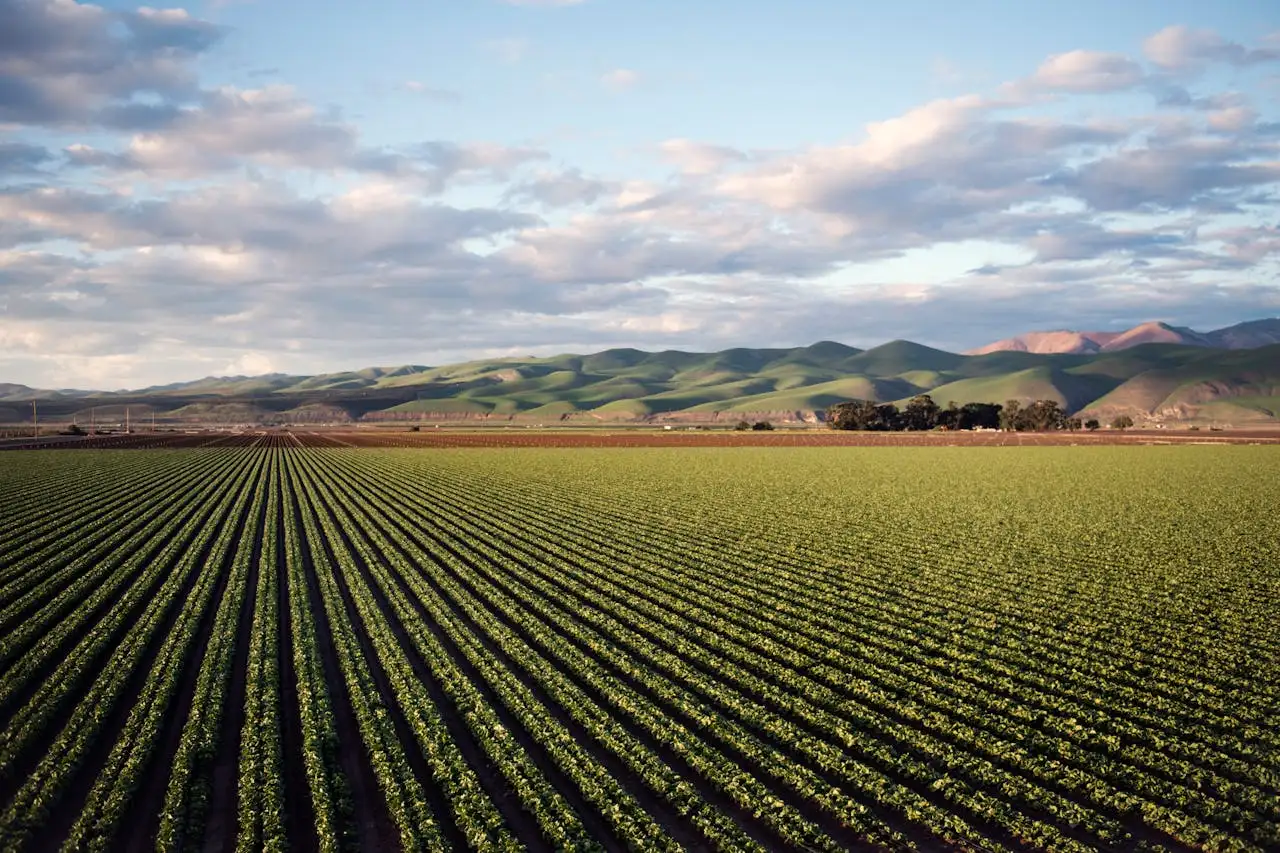 Agro Yield
Agro Yield
09 Jun 2024


10 Jun 2024
Introduction: Why Stability Matters
When you open your favorite stock‑market app and see the S&P 500 diving three percent before lunch, you feel it in your stomach. Fast drops can erase weeks, months, or even years of hard‑earned gains in a single day. That roller coaster is why many investors look for assets that refuse to move on every tweet, headline, or rumor. Farmland, especially in the United States, has shown that kind of calm strength for more than a century. It grows food, it grows value, and—if managed well—it grows income, too. In this long, straightforward guide, we will explore why farmland tends to hold its worth when stocks swing, how it combats inflation, what income streams it offers, and how a platform like Agro Yield Partners selects, manages, and safeguards these assets for individual investors. By the end, you will have a clear picture of farmland’s role in a balanced portfolio and the steps you can take to add this solid foundation to your own investment strategy.
Food demand is famously “inelastic,” which is the academic way of saying people keep buying it even when prices rise or incomes drop. You might postpone a vacation or skip a new phone, but you will still buy bread, milk, beef, or fresh produce for your family. Because farmland sits at the very first step in the food‑supply chain, its revenue line benefits from that steady, unavoidable demand. In the United States, the world’s third‑largest population consumes about 364 million tons of food per year, according to USDA estimates. Moreover, the U.S. farmers export roughly $190 billion in agricultural goods annually, extending demand beyond domestic borders. This massive, basic need creates a floor under farm‑commodity prices: even in recessions, people still eat.
Look back to the Great Depression, the oil shocks of the 1970s, the dot‑com bust in 2000, the Great Recession in 2008, and the pandemic crash in early 2020. Farmland values either rose modestly or declined far less than equities in each of those downturns. According to data from the USDA’s National Agricultural Statistics Service (NASS), average U.S. cropland appreciated about three percent during 2008 while the S&P 500 plunged 38 percent. In 2020, when stocks fell more than 30 percent in March alone, long‑term cropland prices dropped less than one percent for the entire year before resuming their upward trend.
Why is that? First, farmland sales are private and infrequent, so there is no minute‑by‑minute price feed to whip values around. Second, the buyers are often long‑term oriented farmers or institutional investors who use lower leverage than housing speculators. These structural factors dampen volatility.
When inflation climbs, money in a savings account loses buying power because prices of goods and services go up while the cash earns only a small interest rate. Farmland works differently. Many farm leases are based on a share of crop revenue, which rises when crop prices rise. Even fixed‑cash leases can be renegotiated annually. Furthermore, the underlying land itself becomes more valuable as replacement costs—diesel, fertilizer, machinery, even nearby land—grow. In the 1970s, U.S. inflation averaged 7.1 percent per year. During that decade, cropland values posted annual gains of roughly 11 percent, more than keeping pace with the cost of living. Investors who owned farmland preserved their purchasing power and even came out ahead.
A single farm parcel can create revenue in more than one way. Below are the three main categories Agro Yield Partners looks at when underwriting a project:
Crop Sales or Revenue‑Share Rent – If Agro Yield directly operates the farm, crop proceeds flow to investors after expenses. If the land is leased, a revenue‑share model pays investors a percentage of gross sales.
Fixed Cash Rent – Some investors prefer predictability. In that case, the farm tenant pays a set rent each year, regardless of crop outcomes.
Ancillary Programs – These include government conservation payments, solar‑panel leasing on non‑arable corners, wind royalties in the Midwest, or carbon‑credit income for regenerative practices.
By stacking these income channels, a well‑run farm can provide steady cash flow plus long‑term appreciation.
To make these ideas concrete, let’s examine a 320‑acre row‑crop farm in Champaign County, Illinois, that Agro Yield Partners added to its portfolio in 2019. The farm grows corn one year and soybeans the next, which balances soil nutrients and reduces pest pressure. Here are the core numbers:
Purchase Price: $3.2 million ($10,000 per acre)
Cap‑Rate Target: 4 percent (cash rent)
Revenue Share: 25 percent of gross crop sales above a set price threshold
Extra Income: $32,000/year from a small cell‑tower lease on one corner
In the first three years, investors received an average cash yield of 4.8 percent, beating the original target. Meanwhile, comparable land within five miles sold for $11,250 per acre in 2022, indicating 12.5 percent appreciation. Combining those two lines, the internal rate of return (IRR) topped 9 percent—strong for a low‑volatility asset.
Many investors compare farmland to residential or commercial real estate, timberland, or gold. Each asset stands on its own merits, but farmland offers four unique advantages:
Essential Output – Renters can move, but everybody eats.
Renewable Yield – Timber can take 20 years to mature; crops refresh every season.
Positive Externalities – Sustainable farming builds soil health, captures carbon, and protects water quality, attracting ESG capital.
Lower Upkeep Cost – Buildings depreciate and need repairs. Soil, by contrast, can improve each year with good stewardship.
Most financial advisers recommend spreading investments across stocks, bonds, and “alternatives” to smooth returns. Farmland’s correlation with the S&P 500 is roughly 0.05—essentially zero—over the past 50 years. This low linkage means farmland often rises (or at least stays flat) when stocks fall, pulling down overall portfolio volatility. Vanguard, for instance, suggests an allocation of 5–15 percent to real assets for well‑diversified portfolios. Agro Yield Partners makes it feasible for individual investors who cannot write a multimillion‑dollar check for an entire farm.
Not all farmland is equal. Three factors drive valuation the most:
Soil Quality – The USDA’s Soil Productivity Index assigns scores to every acre. Higher scores typically bring higher rent and resale value.
Water Rights – In the western U.S., secure irrigation rights can double or triple an acre’s price. No water, no crop.
Market Access – Distance to grain elevators, produce packers, or export ports affects trucking costs and net income.
Agro Yield’s due‑diligence team inspects each factor in person, checks county records, and uses satellite data to confirm historical yields before any purchase.
Even the best farm cannot escape risk, but thoughtful planning can limit downside:
Crop Insurance – Federal multi‑peril crop insurance protects revenue if drought or floods slash yields.
Forward Contracts – Locking in prices for part of the crop shields against market dips.
Operational Expertise – Experienced managers follow strict budgets, monitor soil health, and use precision‑ag tools to cut waste.
Agro Yield Partners requires a written risk‑mitigation plan for every farm, including alternate water sources and contingency budgets for equipment or labor spikes.
Farmland investors may benefit from several U.S. tax incentives:
Depreciation – Drainage tile, irrigation equipment, and barns depreciate over time, reducing taxable income.
Section 180 Expense – Soil and water conservation costs can be expensed in the year incurred.
1031 Exchange – Investors can defer capital‑gains tax by selling one parcel and buying another of equal or greater value.
Agro Yield’s legal team works with investors’ tax advisers to maximize these breaks while staying compliant.
Critics argue farmland is illiquid. That can be true if you own a farm outright, but Agro Yield Partners offers three exit paths:
Scheduled Sale – Most projects have a planned sale at the end of the investment term.
Secondary Market – Investors can list units on a private bulletin board to other pre‑qualified members.
Refinancing – A farm with strong cash flow can be refinanced to return investor capital while retaining ownership.
These options give flexibility without forcing a sale during a downturn.
The 2021 Growing Climate Solutions Act opened the door for farmers to earn credits for carbon sequestration. Agro Yield Partners has pilot programs where cover‑cropping and no‑till methods generate verifiable carbon credits sold to corporations seeking offsets. Early results show an extra $20–$30 per acre in annual income—small today, but likely to grow as the U.S. carbon market matures. That upside can add one to two percentage points to investor returns without major new costs.
Prudent leverage can magnify gains. Agro Yield typically finances up to 40 percent of a farm purchase with fixed‑rate loans from Farm Credit institutions at rates near 6 percent. Because crops often yield returns above that rate, the spread flows to equity investors. Still, all loans carry conservative covenants, and no project borrows against future appreciation assumptions.
Sign Up – Create a secure account on the Agro Yield Partners portal.
Browse Projects – Review soil maps, financial projections, and manager bios.
Reserve Units – Choose your investment amount; sign documents digitally.
Fund the Investment – Wire funds via ACH or bank transfer.
Track Progress – Monthly dashboards show field photos, yield data, and income statements.
Receive Distributions – Earnings deposit straight to your linked bank account.
Exit or Reinvest – At project end, cash out or roll profits into a new farm.
Stock charts may spike and plunge, but farmland keeps quietly doing its job—growing crops, growing value, and feeding the nation. Its long history of low volatility, inflation protection, and reliable income makes it a natural anchor investment. Through Agro Yield Partners, you can own a slice of America’s most productive land without driving a tractor or fixing a fence. By combining modern precision‑ag technology with age‑old stewardship, we help investors enjoy steady returns while supporting sustainable food production. In an unsteady market, few assets offer that rare mix of security, growth, and real‑world impact. Farmland does, and now it can be part of your portfolio, too.
 Your Money
Your Money